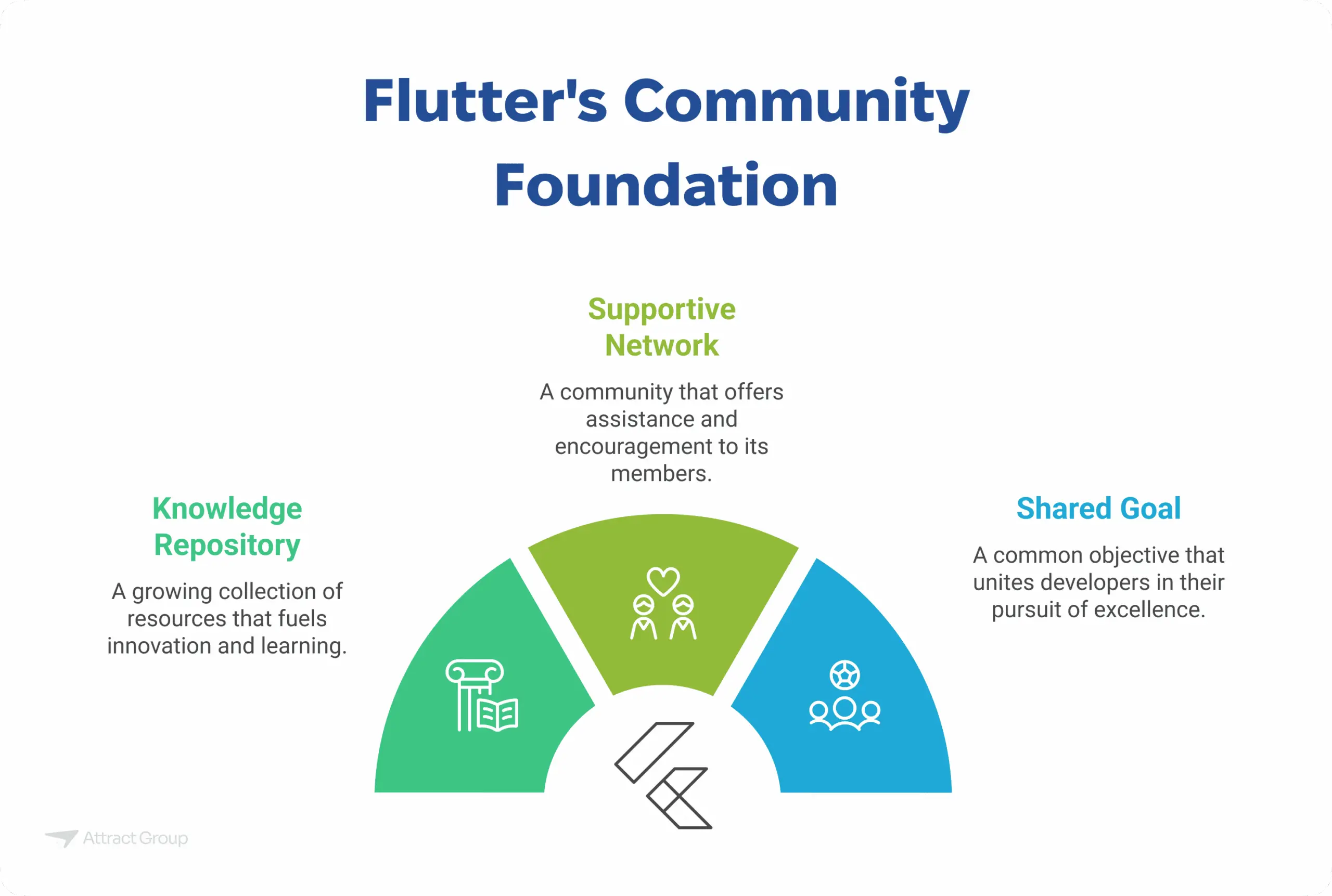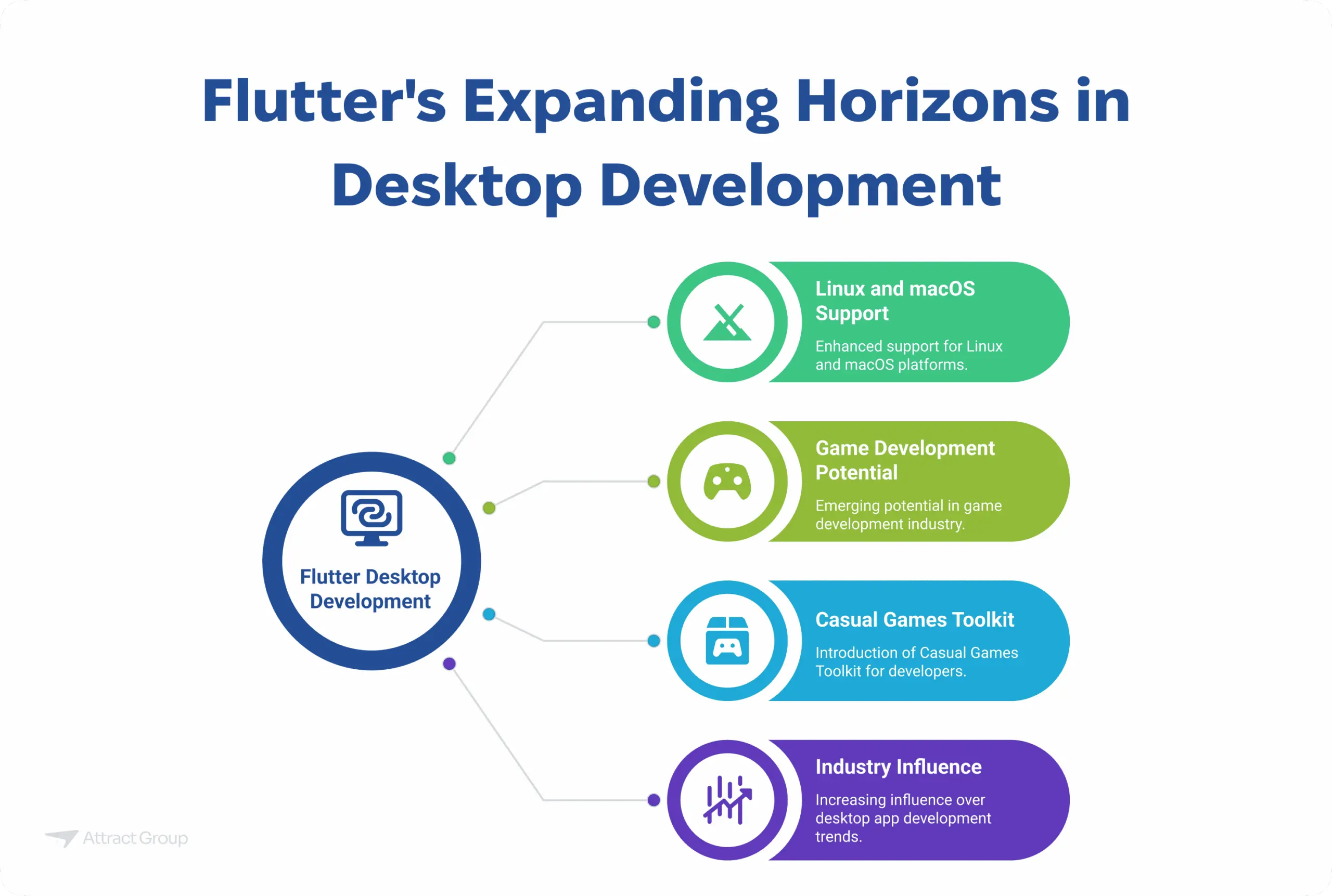Flutter for Desktop Apps: A Comprehensive Guide to Pros, Cons, and Best Practices
 6 February 2024
6 February 2024? Listen to the Summary of this article in Audio
The landscape of desktop app development is evolving rapidly, and Flutter desktop app development is at the forefront of this transformation. As a potent Flutter desktop framework, it has captured the attention of developers globally by extending its capabilities beyond mobile platforms. Since its alpha launch in 2017 and subsequent official launch in 2018, Flutter has not only matured as a robust mobile framework but has also made significant strides in supporting desktop app development with Flutter.
The versatility and rapid growth of Flutter are demonstrated by its surging GitHub stars, now surpassing those of older cross-platform counterparts. Built on a solid foundation with a sophisticated architecture comprised of an embedder, engine, and a framework, Flutter leverages the Dart language devised by Google to offer unparalleled advantages for developers. From sophisticated UI toolkits to the ease of writing a single-codebase, Flutter is poised to reshape desktop app development with agility and precision.

Key Takeaways
- Flutter transcends mobile boundaries, championing cross-platform desktop app development.
- A single codebase with Flutter expedites development cycles across platforms.
- Flutter’s rich widget library ensures UI consistency and speeds up the development process.
- Hot reload feature and a comprehensive set of tools make Flutter a developer favorite.
- Understanding Flutter’s pros and cons can help tailor its framework to your desktop development needs.
- With Flutter’s continuous upgrades, the framework is scaling new heights in desktop app development versatility.
- Developers leverage Flutter to craft high-performance desktop apps that deliver captivating user experiences.
Introduction to Flutter for Comprehensive Desktop Solutions
With innovative strides in technology, cross-platform desktop app development has marked a significant milestone through the rise of Flutter — a transformative framework redefining the norms of how applications can be designed and deployed across multiple platforms. The emergence of Flutter has made it a buzzword within the community of top flutter desktop app developers, promising a streamlined workflow from mobile to desktop app development. This evolution resonates with a growing consensus among developers; Flutter is not solely an advanced tool but a visionary approach to creating desktop applications that meet modern demands for agility and cohesive user experiences.

The undeniable appeal of Flutter has resulted in a swell of interest, reflected in online discussions and trending analyses. A memorable takeaway on a Reddit thread encapsulated the sentiment by asserting,
“We think React Native is mature, but Flutter is the future.”
Attract Group mobile team
Such endorsements have been further quantified by interest over time data, underscoring Flutter’s traction in contrast to other frameworks. This guide seeks to explore the fabric of Flutter desktop app development, charting its ascent and unveiling reasons that bolster its position as the go-to technology for forward-thinking desktop solutions:
- Advantage of leveraging a single codebase for diverse platform applications, including desktop environments
- Recognition of best flutter desktop app development practices through community insights and trends
- Understanding how top flutter desktop app developers harness this technology to create groundbreaking desktop apps
Best practices in Flutter development highlight principles like code reusability and consistency, coupled with the framework’s inherent efficiency — a symphony of features that amplify Flutter’s standing in the realm of desktop application development.

As our guide unfolds, we will delve deeper into the functionalities and features that have earned Flutter such commendable regard. The proficiency with which Flutter has been adopted for desktop app development using Flutter substantiates its definition as a comprehensive and adaptable framework. The overarching narrative among developers is clear: Flutter stands as a pioneering force for crafting desktop applications that merge beauty with performance, extending the invitation to reimagine the potential of desktop apps.
What is Flutter?
At the heart of modern software development, what is Flutter is a question that reverberates across the tech community. To demystify, Flutter is an open-source UI toolkit introduced by Google, which serves as much more than a mere framework or library. It encapsulates a complete SDK, adept at bolstering Flutter app development for mobile, web, and desktop platforms under one cohesive codebase. Its inception has been a game-changer for developers who yearn for versatility and performance in their applications.

Unraveling the layers of Flutter reveals its core structured around the efficient programming language Dart. Dart is Google’s brainchild, optimized for client-side development and conducive to compiling directly into native code. This not only expedites startup times but also substantially augments the overall performance — a significant criterion in app development today. Its capability to directly compile into native code without intermediate interpretation layers stands as a testament to the ingenuity behind Flutter’s architecture.
When addressing Flutter desktop UI and Flutter desktop application development, one must note the extensive suite of libraries and widgets that come with Flutter. These components are the linchpins of the SDK, empowering developers to scaffold desktop applications with finesse and efficiency. The widgets are particularly lauded for their organized structure, facilitating a streamlined development process and ensuring that the UI remains harmonious across multiple platforms. Thus, for a developer keen on constructing a high-caliber, cross-platform desktop UI, Flutter emerges as an increasingly attractive and pragmatic choice.

- Endows developers with the capability to devise applications with a single codebase for mobile, web, and desktop
- Features a rich assemblage of widgets and libraries that caters to a diverse range of functional and aesthetic requirements
- Utilizes Google’s Dart language, allowing applications to be compiled directly into native machine code
- Eliminates need for separate bridges to communicate with the platform, thus enhancing performance and delivery
Partner with our expert Flutter developers to build a fast, responsive desktop app using Flutter’s robust architecture and toolset.
In conclusion, Flutter stands as an all-encompassing SDK, entrenched in flexibility and prowess. It exemplifies the evolution of app development, stretching the horizons of what can be achieved with cross-platform synergy. As developers and brands turn to Flutter for their digital solutions, it is clear that Flutter is pacing forth as a frontrunner in the tech realm.
Flutter Desktop App Development: The Pros
Embracing Flutter desktop app development reveals a wealth of benefits that streamline and refine the software creation process. Its cross-platform nature and rich feature set have made it the choice for developers and companies seeking Flutter desktop app development services.
Cross-Platform Efficiency
One of the standout advantages of using Flutter for desktop app development is the unparalleled efficiency achieved through a unified codebase. This approach paves the way for transformative hybrid app development practices, allowing deployment across mobile, web, and desktop with remarkable agility. The introduction of Flutter 3 has notably expanded this efficiency to include full-fledged support for desktop operating systems like Linux and macOS, further widening the horizon for developers.
UI Consistency and Flexibility
Maintaining a consistent and engaging user interface is paramount in application development. Flutter’s desktop UI capabilities shine in this regard, providing a treasure trove of customizable widgets. These widgets serve as the foundational elements of Flutter’s design, ensuring UI consistency and offering the flexibility to achieve both Material and Cupertino design languages effectively. This fusion of consistency and adaptability simplifies the process and elevates the overall user experience.
Community and Support
A thriving and inclusive community forms the backbone of any successful technology, and Flutter is no exception. Dedicated Flutter desktop developers contribute to a growing repository of knowledge, packages, and libraries, which enriches the ecosystem and catalyzes innovation. Newcomers and experts alike find a supportive network, ready to assist, troubleshoot, and champion the shared goal of excellent desktop application development.

Performance
The performance of applications made with Flutter is difficult to overstate. Adopting Dart and compiling directly to native code, Flutter facilitates high-fidelity, seamless user experiences that rival native desktop applications. Its robust compilation process, including both AOT and JIT, ensures that apps are not only fast and responsive but also maintain visual integrity and operational smoothness across different platforms.
| Feature | Description | Advantage |
|---|---|---|
| Single Codebase | One codebase for mobile, web, and desktop. | Saves time, increases consistency. |
| UI Widgets | Comprehensive set of customizable UI components. | Speeds up UI development, ensures platform consistency. |
| Community Support | Robust support from a community of developers and contributors. | Facilitates learning and problem-solving. |
| Performance | Compiles to native code for high-performance applications. | Delivers a smooth, responsive user experience. |
As illustrated in this table, the pros of desktop app development with Flutter are undeniable. Whether searching for the best Flutter desktop app development company or seeking to refine skills as a Flutter desktop developer, these advantages lay the foundation for success in the rapidly evolving landscape of application design and deployment.

Flutter Desktop App Development: The Cons
While Flutter desktop application development presents significant benefits for developers, certain drawbacks must be addressed to provide a holistic view. Despite its flexibility and efficiency, there are native feature limitations, package availability issues, and resource usage concerns that can impact the overall app performance and developer experience.
Limited Native Features
One of the noted desktop application development limitations of Flutter is its restricted access to native features. Although Flutter’s platform channels facilitate interactions with native APIs, some of the more specific or advanced native functionalities might not be directly available. In some instances, reaching these capabilities can entail extra layers of bridge code, putting a strain on the development process and possibly hindering the final product’s native feel and performance.
Our Flutter developers can help you maximize Flutter’s benefits while mitigating any limitations through custom solutions.

Package Availability
The Flutter ecosystem, while continually burgeoning, sometimes faces Flutter app development constraints due to limited Flutter packages. The breadth of third-party packages for Flutter is indeed growing, but it can fall behind more established frameworks. This scenario may require developers to invest time in finding Flutter desktop framework packages or even developing custom integrations to achieve the necessary functionality for their applications.
Resource Usage
In comparison to their native counterparts, Flutter applications typically come with a larger package size. This increase is partly due to the bundled Flutter engine and often leads to significant binary sizes. For users with limited storage, or for developers who prioritize a smaller application footprint, this can be a less-than-ideal characteristic — one where Flutter’s resource usage may not align with project or user requirements.
These constraints are illustrated below, summarizing the main challenges developers may encounter with Flutter desktop app development:
| Constraint | Impact on Development | Potential Mitigation |
|---|---|---|
| Native Feature Limitations | Restricts access to specific platform functionalities | Additional bridge code or custom solutions |
| Package Availability | Limited access to certain types of functionalities | Finding alternatives or creating custom packages |
| App Size | Larger initial download | Optimization efforts to reduce the binary size |
Despite these challenges, the appeal of Flutter for building desktop applications continues to thrive, with developers finding creative ways to overcome the mentioned drawbacks. The balance between the ease of development and these discussed constraints will ultimately guide the choice between Flutter and other development frameworks.
Flutter Desktop Development Services
In the domain of software engineering, flutter desktop app development services have carved out a significant niche, commanding attention for their ability to facilitate the creation of versatile, cross-platform desktop applications. These services provide an arsenal of development tools and an ecosystem that encourages consistency in performance and engaging user experiences across diverse desktop environments. At the confluence of innovation and tradition, desktop app development using Flutter stands as a beacon for transformative developmental practices.
The hallmark of Flutter is its utilization of a single codebase philosophy, wherein code once written is deployable across multiple operating systems. This principle not only streamlines the development process but also ensures uniformity and stability throughout an application’s lifecycle. Among the wealth of benefits, one of the most compelling is Flutter’s rich compilation of widgets and libraries that are immensely beneficial in crafting user interfaces with high-end aesthetics and functionality.
Delving further into the essence of what makes Flutter an optimal choice, it is its native performance capabilities. Dart, the programming language behind Flutter, allows for direct compilation to native machine code, enhancing the overall efficiency of applications. In an era where time and resources are invaluable, leveraging the proficiencies of Flutter virtually guarantees a quicker turnaround without compromising on quality or user satisfaction.
| Feature | Benefit |
|---|---|
| Uniform Codebase | Streamlined development and maintenance for multiple desktop platforms. |
| Rich Widget Compilation | Enhanced user experience with customizable and consistent UI elements. |
| Native Performance | Efficient and fast applications that feel intuitive on all desktop environments. |
Equally important is the ongoing support and evolution of Flutter as a framework, continually being upgraded with new features and widgets that enhance its capacity to handle complex desktop scenarios. Thus, the services surrounding flutter desktop app development are not static but dynamically adapting to the advancing needs of the market, staying ahead of the curve in technology trends. For businesses and individual developers alike, there’s no denying the transformative impact that Flutter brings to the table.
In summation, the multifaceted services offered by Flutter for desktop app development encapsulate a blend of traditional robust programming conveniences with modern, user-centric design philosophies. These attributes come together to provide a foundation that is both resilient and adaptable to the demands of current and future desktop application development projects.
Case Studies: Successful Flutter Desktop Apps
The ascent of Flutter as a versatile development platform is well-illustrated by a series of successful Flutter desktop applications. These case studies showcase how businesses, from prominent brands to burgeoning startups, have effectively leveraged Flutter to create high-quality desktop applications.
One point of interest involves the journey of renowned global companies like BMW. The company has adopted Flutter to develop immersive and brand-enhancing customer experiences on desktop platforms. Likewise, startups have found a robust ally in Flutter — most notable among them is Nubank, Latin America’s largest neobank. By adopting Flutter, Nubank has accelerated its growth trajectory, drawing upon Flutter’s ability to deliver consistent, natively compiled applications across desktop and mobile platforms.
Another intriguing case study of Flutter development is that of Reflectly, an AI-based mental health application. The platform used Flutter to create a seamless user experience that translates effectively across various desktop interfaces, substantiating Flutter’s promise of fluid aesthetic and functional performance.
- BMW: Developed interactive and compelling desktop applications using Flutter, enhancing customer touchpoints.
- Nubank: Utilized Flutter to scale its desktop app, achieving a uniform user interface and functionality across platforms.
- Reflectly: Leverage Flutter for a cross-platform mental health app, promoting well-being with a harmonious user experience.
- Flustr: Social network with live streams. ONLINE BATTLES between users by any topic.

These instances illuminate the breadth of Flutter’s technological landscape and its capacity for crafting influential desktop applications. Flutter has demonstrated unparalleled flexibility and robust performance, addressing diverse business needs and contributing to enhanced user engagement and brand loyalty. The array of successful deployments articulates Flutter’s growing significance in the realm of desktop app development.
Let our expert Flutter developers build your next high-performing, multi-platform desktop app.
Developing a Flutter Desktop App: Best Practices
As the landscape of application development steadily shifts to more unified and streamlined methodologies, best practices in desktop app development have become instrumental in shaping successful projects. Specifically, when developing desktop apps with Flutter, there are key practices that significantly enhance both the efficiency of the process and the quality of the resulting software.

Central to Flutter’s appeal is its hot reload feature, which is far more than a mere convenience. It enables developers to witness the application of code changes in real-time, aiding in rapid iteration and refinement — a process that’s fundamental to an intuitive development cycle. This feature not only enhances productivity but also encourages a more creative exploration of design possibilities.
Another cornerstone of Flutter’s best practices revolves around its expansive widget library. This diverse ecosystem of pre-existing and customizable UI components is instrumental in crafting interfaces that are not only rich in functionality but also consistent and aesthetic across diverse desktop environments. Leveraging such an asset is crucial in meeting today’s UX standards and delivering applications that resonate with users.
The supportive community of Flutter is a vast repository of knowledge and a critical aspect of Flutter’s best practices. An active community comprises developers and contributors who are constantly driving the framework forward. Embracing this culture of collaboration can provide invaluable insights, troubleshooting advice, and foster a spirit of innovation essential to overcoming development challenges.
| Best Practice | Benefit | Implementation Tip |
|---|---|---|
| Utilize Hot Reload | Speeds up the development cycle by applying code changes in real-time. | Constantly test and integrate small code changes to observe effects and refine features quickly. |
| Maximize Widget Library Use | Provides a high-quality, consistent UI with less manual effort. | Familiarize with the range of widgets available and customize them to fit the app’s design language. |
| Engage with the Community | Access to collective knowledge and debugging assistance. | Participate in forums, contribute to discussions, and utilize shared resources for continuous learning. |
By marrying these best practices with the already formidable feature set of Flutter, developers can forge ahead with confidence, constructing applications that are not just functional, but are also elevated experiences. In this steady pursuit, best practices in desktop app development, specifically when it comes to developing desktop apps with Flutter, become less of a guideline and more of a pathway to innovation in the digital space.
Flutter vs. Other Desktop App Development Frameworks
When choosing the right tool for desktop application development, a detailed comparison between Flutter and other desktop frameworks is indispensable for making an informed decision. This section contrasts Flutter’s strengths against its competition, highlighting the factors that make it a standout choice in the arena of cross-platform solutions.
Flutter’s single codebase approach dramatically simplifies the development process by ensuring that the same application can run on multiple platforms without significant changes. It eclipses traditional frameworks which often require separate codebases and development cycles for each platform.

The performance of Flutter is another aspect where it shines bright in the realm of desktop application development comparison. Its architecture is designed to compile directly to native code, minimizing performance bottlenecks and providing an experience that rivals native applications on all desktop platforms.
Beyond performance, Flutter’s commitment to continuous updates and an expansive set of pre-built widgets equips developers with up-to-date tools and functionalities for crafting sophisticated applications. In contrast, other desktop frameworks might necessitate additional time and resources to achieve similar results.
A critical examination of Flutter versus other frameworks paints a clear picture:
| Framework | Codebase | Performance | Widgets and Tools | Community and Ecosystem |
|---|---|---|---|---|
| Flutter | Unified | High (close to native) | Rich library of widgets | Actively growing, with Google backing |
| React Native | Unified with some platform-specific coding | Good (with some overhead due to bridge) | Extensive, community-driven | Very large and mature |
| Electron | Unified | Moderate (web-based rendering) | Limited, depends on web technologies | Large and established |
| Xamarin | Unified with some platform-specific coding | Good (with some overhead due to compilation) | Fair, leverages .NET libraries | Mature, backed by Microsoft |
Notably, while frameworks like React Native and Xamarin offer the benefit of a single codebase for mobile app development, they may occasionally require platform-specific adjustments. Electron, heralded for its simplicity in creating desktop applications using web technologies, tends to face performance issues due to its dependence on web-based rendering. Moreover, Xamarin’s reliance on .NET libraries presents a different development paradigm that might not suit all requirements.
Nevertheless, it is the dynamic updates and the growing repository of widgets and tools that give Flutter an edge, allowing efficient and rapid prototyping and development — a vital advantage in today’s fast-paced market. These attributes contribute notably to Flutter’s competitive edge in the comparison of desktop application development frameworks.
Despite its younger ecosystem, Flutter is quickly catching up with more established communities, thanks to strong interest and support from developers worldwide and Google’s ongoing investment in the framework. Ultimately, when considering Flutter versus other desktop frameworks, one must not only look at the current state but also the trajectory of growth and innovation that Flutter promises for the future of desktop app development.
Future of Flutter in Desktop App Development
The trajectory of Flutter desktop development is setting a course for significant impact in the desktop app sector. With the recent advancements seen in Flutter 3, a broader door has been opened for the framework to not only support Linux and macOS but also to venture into uncharted territories like game development. A testament to its growing versatility is Flutter’s new Casual Games Toolkit, which signifies its potential to become a serious contender in the gaming industry. The future of Flutter desktop development is being etched out as we speak, with a strong indication that its influence over desktop app development trends will only escalate.

Embracing the future, Flutter aims to offer an inclusive toolkit that empowers developers to weave complex desktop applications with fewer constraints. There is a palpable shift in developer mindsets, recognizing the strategic advantage involved in adopting Flutter for their desktop endeavors. It’s becoming increasingly clear that as the landscape matures, Flutter’s role in desktop app development will not only grow in relevance, but also expand in terms of capabilities, platforms served, and industries influenced.
Below is a detailed projection of how Flutter is expected to evolve and transform desktop app development:
| Trend | Projection | Impact on Industry |
|---|---|---|
| Multiplatform Support | Provision for stable Linux and macOS capabilities. | Widens developer base and app reach. |
| Integration with Gaming | Introduction of the Casual Games Toolkit. | Opens Flutter to new markets and creative possibilities. |
| Performance Enhancements | Continued improvements on compilation and runtime efficiency. | Delivers higher quality and responsive applications. |
| Expanded Ecosystem | Growth in libraries, tools, and community contributions. | Encourages innovation and smoothens the development journey. |
Such advancements exemplify Flutter’s commitment to staying ahead of the curve, underpinned by Google’s unwavering support and the fervent engagement of a growing developer community. With a sharp eye on the evolving needs of today’s tech environment, Flutter’s propulsion into the desktop app development trends of tomorrow seems not just probable but inevitable.

As we witness the ongoing metamorphosis of this robust framework, it’s hard to ignore that the future of flutter desktop development may very well redefine how we perceive cross-platform app creation. In an era where adaptability and rapid deployment are king, Flutter is positioned to offer a cornucopia of resources that bring efficiency and creativity to developer’s fingertips.
Conclusion
In the evolving landscape of software development, Flutter app development has come to represent a significant paradigm shift. This comprehensive exploration posits Flutter not only as a robust tool for mobile but also as a powerhouse in desktop app development. Entering into the realm of Flutter offers a dual advantage: a vast ecosystem that encourages resource sharing and innovation, and a supportive community ready to propel projects forward.
While every technology has its limitations, the benefits of Flutter’s desktop app development outshine its constraints. Its holistic approach, combining efficiency, expressiveness, and the power of a single codebase, makes Flutter a strategic asset for businesses aiming to harness the next wave of desktop applications.
What truly sets Flutter apart is its flexibility and ease of UI development. Flutter’s widgets enable the seamless creation of sophisticated UIs that function impeccably across multiple platforms. Whether for startups or enterprise-level projects, Flutter’s desktop app development framework accords unmatched consistency and performance.
It is essential to underline that Flutter’s effectiveness hinges on the particular demands of a given project. An analytical approach to Flutter’s attributes helps in discerning its suitability for specific development goals. Yet, businesses and developers who prioritize innovation, rapid development, and cross-platform compatibility will often find that Flutter fits snugly into their vision.
This conclusion is not merely speculative but rooted in factual evidence. The increasing adoption rates, the continuously growing GitHub stars, and the active discussions across online forums solidify Flutter’s position in the industry. While the journey of Flutter app development is still in its growth phase, its trajectory suggests a burgeoning future where Flutter stands as a cornerstone for cross-platform desktop application innovations.
| Core Attraction | Advantages | Project Suitability |
|---|---|---|
| Unified Ecosystem | Facilitates sharing, lowers barriers to entry | Ideal for projects that target multiple platforms |
| Community Support | Vast knowledge base, collective problem-solving | Beneficial for developers at all levels |
| User Interface Expressiveness | Highly customizable and consistent UI widgets | Projects that value aesthetic appeal and UI functionality |
| Single Codebase | Streamlines development, enhances productivity | Suited for projects with accelerated timelines |
To encapsulate the flutter desktop app development conclusion, it emerges as a refined, practical solution poised to satisfy a spectrum of desktop app development needs. Tethering the unique demands of a project with Flutter’s expansive suite of tools and its vibrant community reveals the potential for this framework to not just thrive, but lead and transform the industry of desktop application development.
Our Flutter developers have the skills to turn your vision into an engaging, unified desktop app experience.
FAQs
What is Flutter, and how is it used for desktop app development?
Flutter is an open-source UI software development kit created by Google for building natively compiled applications for mobile, web, and desktop from a single codebase. It uses the Dart programming language and provides a rich set of widgets and tools that facilitate the development of visually appealing and performant applications on multiple platforms, including desktop operating systems like Linux, macOS, and Windows.
Can you build cross-platform desktop applications with Flutter?
Yes, Flutter enables cross-platform desktop app development. With Flutter, developers can write a single codebase to create apps that run on various desktop platforms, streamlining development and ensuring consistent performance and user experience across devices.
What are the benefits of using Flutter for desktop app development?
Benefits of Flutter for desktop app development include its cross-platform efficiency, UI consistency and flexibility, active community and support, and performance advantages due to its native code compilation. These attributes make Flutter a top choice for developers looking to create high-quality, responsive desktop applications efficiently.
Are there limitations when developing desktop apps with Flutter?
While Flutter offers numerous advantages, there are some limitations, such as a limited access to certain native features, fewer third-party packages compared to older, more established frameworks, and larger app sizes due to the inclusion of the Flutter engine and framework within the app.
How does the Flutter community contribute to desktop app development?
The Flutter community is a vibrant and growing network of developers who actively share knowledge, contribute packages, support new users, and create tutorials and resources. This community support is valuable for both newcomers and seasoned professionals in overcoming challenges and keeping up with the latest developments in Flutter desktop app development.
What sets Flutter apart from other desktop app development frameworks?
Flutter is distinct from other desktop app development frameworks due to its single unified codebase for developing on mobile, web, and desktop, and its high-performing architecture. It provides a rich set of widgets and automated testing features that are advantageous for building high-quality apps efficiently.
Is Flutter a good choice for developing enterprise-level desktop applications?
Yes, Flutter is suitable for enterprise-level desktop applications. It has been used successfully in various enterprise projects, proving its capability to build scalable, expressive, and performant apps. Organizations select Flutter due to its rapid development cycle, consistent UI, and ability to deploy across platforms with a single codebase.
What best practices should be followed when developing desktop apps with Flutter?
Best practices in Flutter desktop app development include leveraging the hot reload feature for quick iteration, maximizing the use of Flutter’s extensive widget library for UI, and engaging with the community for support and shared expertise. It’s also important to thoroughly test the apps across platforms and maintain code quality through clear documentation and modular design.
Is Flutter capable of developing desktop games?
With the release of Flutter 3 and the Casual Games Toolkit, Flutter has stepped into the game development area, offering tools and capabilities necessary for developing casual desktop games. While it may not replace dedicated game engines for more complex game development, it is certainly capable of handling simpler gaming applications on the desktop.
What does the future hold for Flutter in desktop app development?
The future of Flutter in desktop app development is promising. With ongoing enhancements, increased stability for Linux and macOS, and a focus on expanding its tools and packages, Flutter is set to become even more prevalent in the industry. As it continues to grow in capability and popularity, it is expected to be a mainstay in cross-platform desktop app development.










